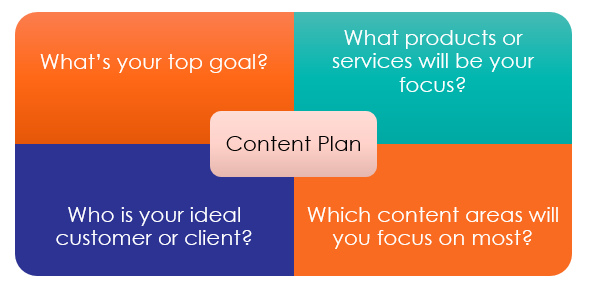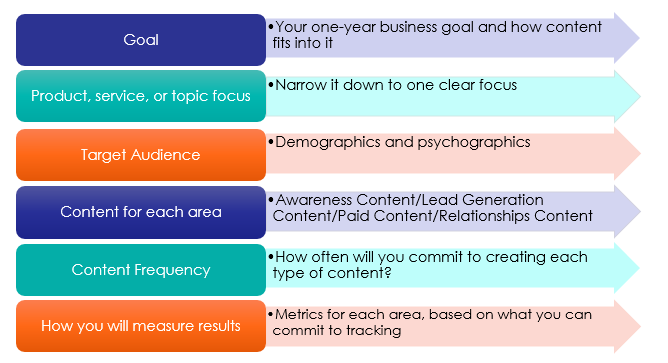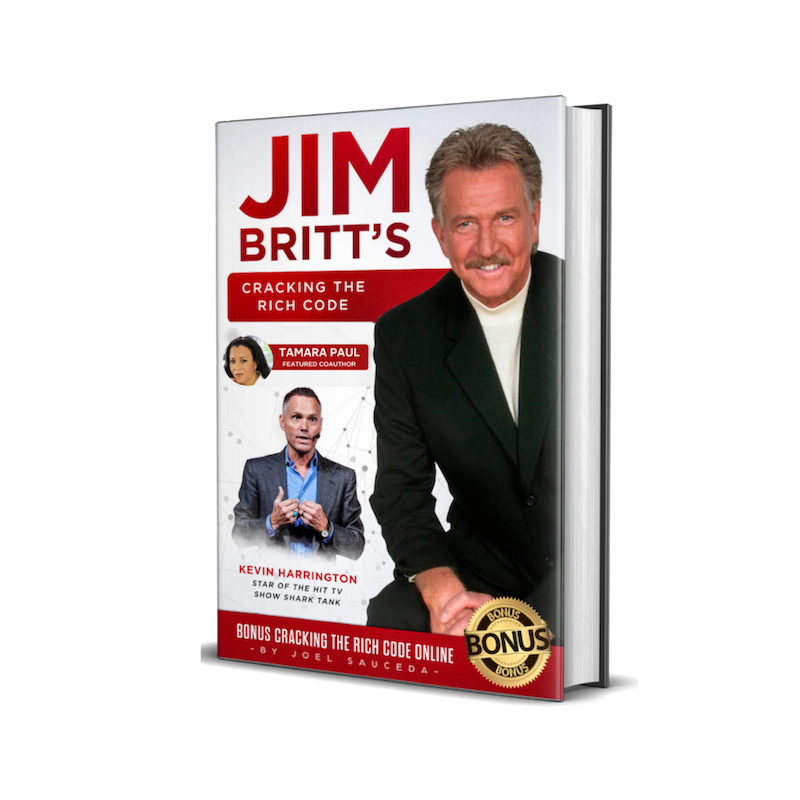Welcome to
Develop a Content Marketing Plan with EaseDeveloping content that will speak to your audience
Module Three
What Plan Can You Realistically Commit to?
Content creation and publishing always takes a great deal of time, work, and effort. To make sure this time is well spent and that you can commit to it for the long-term, you need to create a plan that will move you towards your goals and be realistic to maintain.
In this module, we’ll discuss creating your content plan. This is different from an editorial calendar. It is a more high-level view of what you’re doing. An editorial calendar simply puts each piece of content down on a schedule to make implementation easier and more efficient.
A good way to create a content marketing plan is to answer the following questions:

- What’s your top goal?
- What products or services will be your focus?
- Who is your ideal customer or client?
- Which content areas will you focus on most? In other words, which will have the highest impact on achieving your goals?
You should have already answered these questions earlier in this course. Here are other questions to ask to make sure your plan is realistic to implement.
How much time and resources can you realistically commit to each area?
Decide how much you can commit to each content area, keeping in mind that your needs will differ for each. Awareness and relationship-building content is needed on an ongoing basis. You have to continue to provide value and build relationships with your audience. However, paid content and content for lead generation can be created on a one-off or project-by-project basis.
What content do you already have that you can leverage to save time?
You probably have some old content lying around on your hard drive or published in different places that you can update or repurpose to create new content. This helps to make a realistic plan for your content because you’re leveraging content you already have, and thus cutting down on your workload.
Awareness: Good content to repurpose for awareness might include blog posts you can update or expand to be more timely; content that you can cut up and make social media posts out of; or old webinars that you can turn into a podcast, videos, or text-based content.
Lead Generation: Examples of repurposed lead generation include a blog post series transformed to an eBook; an old information product updated into a new product for a lead magnet; or a course or content series that you can turn into webinar content.
Relationship Building: To build relationships with your followers, you can turn old blog posts into email list messages; take old paid products and offer them to your subscribers, social media followers, customers, or list members as an exclusive bonus; use an interview with a relevant influencer or expert in your niche and offer it to your audience.
Paid Content: For paid content, you can bundle content together into a new information product to sell; offer unused or updated content as part of an archive for a paid membership site; or update an old sales page to sell a new product or new version, or to reflect changes in your market.
What type of content do you enjoy creating?
You shouldn’t focus on just creating the content that you like – for best results, you should be creating the content your audience likes. But if you can adjust your content plan so that you enjoy the process of creating content, you’ll get more done and it will be better quality because your enthusiasm will go into what you create.
If you’ve created content before, you probably have a pretty good idea of what you like to create. You may be someone who loves the written word. On the other hand, you may feel that writing is not your strength, and creating infographics or video tutorials is much more fun. Try to pinpoint the types of content you enjoy creating and make this a major part of your content strategy (as long as your audience also enjoys it).
One thing to keep in mind is that if you don’t enjoy content creation or creating certain types of content, you’ll need to delegate or outsource this to someone in the future for best results. If you hate writing, you’re not going to be able to keep up with the demands for written content as your business scales.
Mixing Content Types
Content may overlap into more than one core category. A blog post that you use to build awareness could also be something helpful that your current customers, with whom you’re already building relationships, would enjoy.
You’ll mix content types within your plan’s aims. For example, you may offer a paid product to your email list. This earns you a profit while also qualifying leads. Post-purchase, your follow-up emails with helpful tips related to the product they purchased will deepen your relationship with them.
Measuring the Results of Your Content Marketing
It’s important to measure your results in objective, data-based ways. This is the only way you can determine whether you’re achieving your goals or not. Find a few metrics that will tell you how you’re doing for each goal.
For awareness, this is where people are first coming into your orbit. Here, you should be measuring the number of people coming in and consuming your content. Metrics can tell you how many people are signing up, following you, or visiting your website. For example, if you have a blog post whose purpose is to encourage people to explore other content on your site, you can track where people go after reading that post. If you’re using video content, you can measure new YouTube subscribers and track views.
Lead generation goals are similar to awareness goals, but easier to measure because you’re asking a lead to take a certain action; for example, they’re signing up for your list, whereas awareness could be just measuring people seeing, reading, or spending time with your content.
It’s easy to measure paid content because you can look at sales. Sales can also be tracked to their traffic sources. If you’re promoting a product, you can track its sales back to which sales page, blog post, article, information product, or social media post the traffic came from.
Relationships are the hardest to measure because they’re not data driven. You gradually build up a relationship and it’s not easily measurable. However, if you have a relationship with your audience, you’ll see engagement as a result, and you can measure this engagement. Look at comments, likes, and shares. Look at email replies and conversations. You can get feedback directly through surveys, asking what pieces of content your audience liked best.
Set aside some regular time in your schedule for monitoring the results of your content plan. Choose just one or a handful of metrics to measure that are directly related to the results you want to get. Keep in mind that you may not see results at first; it may take some time before your content starts working.
It’s best to choose only a small handful of metrics to make your plan realistic. Metrics programs offer all types of information, which can be overwhelming. Try to only look at data that’s directly related to your goals.
When watching metrics, repeat whatever efforts produced results. For content that doesn’t do anything, change your strategy or choose other topics to cover.
Create a One-Page Content Marketing Plan
Now that you’ve thought about all of these factors, it’s time to put it all together into a one-page document that outlines your content marketing plan. You can’t get too detailed on a single page, but one page gives you a concise summary that can be taken in at a glance. The plan will clearly describe what content you will create for each area considering your goals, time, resources, and preferences.
Your one-page content marketing plan should include:

- Goal
- Your one-year business goal and how content fits into it
- Product, service, or topic focus
- Narrow it down to one clear focus
- Target Audience
- Demographics and psychographics
- Content for each area
- Awareness Content
- Lead Generation Content
- Paid Content
- Relationships Content
- Content Frequency
- How often will you commit to creating each type of content
- How you will measure results
- Select metrics for each area, based on what you can commit to tracking
Once you have your one-page plan, you can use it to fill out an editorial calendar, which will get you started. This will be covered in the next module.
Activity:
- Answer the additional questions in the module that will determine what’s realistic for you to commit to
- Create your one-page content marketing plan. Use the provided template and base it on the answers to the questions in this module. Be sure to identify the type of content you’ll create for each area, the purpose of each piece, the frequency, and some idea of the length. Keep in mind that:
- Awareness and relationship-building content needs to be published on a regular schedule
- Lead generation content is usually a one-time set-up that’s revisited regularly
- Paid content is based on your business model. You may not need anything at all here.
Cracking the Rich Code
"Whether you’ve been stuck on the sidelines waiting for the “right time” to launch your business or struggling to “generate” the life changing results from your business- This is your time to start saying “YES” to opportunity and “NO” to the noise. 100% of us entrepreneurs need answers and solutions. Join me to get updated on what it takes to prepare yourself and stay ahead of this changing business world."

Our superpower is making you a superhero.


